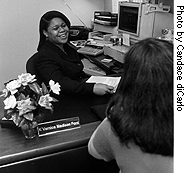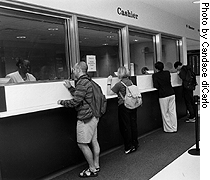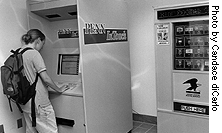 |
|
Location, location, location:
Pulling five services together on the first
floor of the Franklin Building streamlines a historically cumbersome process
for students.
In the ultimate best-case scenario, they
don't have to go there at all.
 |
A transformed first floor of the Franklin
Building houses the PENNCard Center, a unit
of Business Services, along with Registrar's staffers
including Brenda Bundy, above.
|
One-Stop Shopping in Student Administrative
Services by Frank Claus
On the first floor of the Franklin Building a student will now find:
- Student Financial Services
- The Registrar
- The Cashier
- The PennCard Center
These offices constitute core administrative services, which affect all
enrolled students. Each of the offices has remote access capabilities, though
PENNCard requires a photograph and thus a visit. When special attention
is needed these offices can give expert assistance with maximum convenience.
Student Financial Services
In 1988 the concept of one-stop shopping got started in earnest at Penn--at
least insofar as student finance was concerned--with the founding of a unified
Student Financial Services drawing together Financial Aid, Loans and Bursar.
But, streamlining the details surrounding students' financial dealings
with the University goes beyond creating an organizational entity. Coping
with the cost of attendance, and the stress associated with student financial
processes, requires a variety of approaches designed to meet the needs of
students and the academic and social structure of the life that students
follow.
This is the basis of our grouping of services in the renovation of the
Franklin Building's first floor, so that five separate operations, in three
separate reporting lines, are now found by the student with only one visit.
Two of the services--Penn Card and the 24-hour Penn In Touch facility with
its handy stamp machine--also serve the faculty and staff.
Evolving technology has provided some of the solutions, and SFS is pursuing
three goals to take advantage of new ways of doing things:
1. Reduce the need for students to visit the central facility.
By automating loan check disbursement, 80% of all loan disbursements are
now achieved electronically by credit to the student account. This year
SFS also introduced a program that permits students to directly deposit
refunds to their bank account. Almost 3000 students signed up for this service,
avoiding the need to visit SFS for their checks. SFS has also introduced
an e-mail service, FAX service, a sophisticated telephone system, and a
web site where many questions can be answered. While forms have been eliminated
wherever possible, and more will be eliminated, those that remain are available
on the web as well as by mail.
2. Place in the hands of students and administrators the means
to solve their own problems.
Penn-In-Touch permits students anywhere in the world to have access to
their own financial and registration information. This program is a joint
effort of the Office of the Registrar, UMIS, and SFS. Within the secure
environment of Penn In Touch, a student can change his/her address, review
his/her account, register for courses, get an unofficial transcript, check
financial aid status, and e-mail messages to appropriate departments. Forms
will some day be eliminated in favor of electronic entry. Besides Penn In
Touch, SFS has an extensive web site, improved literature, and telephone
inquiry capabilities.
To assist administrators, SFS instituted SFSEASI, a fully distributed
computer system which captures student information from several systems
and permits easy navigation between SFSEASI, SFS, and the Student Financial
Aid system.
3. If a visit is necessary, the first contact should solve the problem
if possible.
Partly by drawing services together in one location, and partly through
redoubled staff training and effort, SFS made its primary objective to have
the first person contacted solve the student's financial issue if possible.
Reducing referrals is at the heart of the plan.
Students once lined up to wait for service at a counter where they would
discuss confidential and sometimes embarrassing situations within earshot
of classmates, there is now privacy in the consulting process.
Student Financial Counseling Center
Students now have privacy in discussing their financial affairs with
counselors like K'Vernice Madison Ford, at right. |
 |
Instead of a snake line, students enter a Reception Center,
to be greeted by receptionists who can tell them immediately how long a
wait is ahead. (In fact, a student can observe the wait-time on entering
the Franklin Building lobby, where a TV monitor displays it. The monitor
also provides useful information about deadlines, directions--and may in
the future have CNN news.)
After either signing in or swiping his/her PENNCard, the student is logged
into an automated queuing system that keeps track of which student is next
and which counselor is available, and notifies the student by monitor which
"office" to go to. The same system alerts two key figures in the
service: a Counselor is informed of the student's arrival, his school, estimated
year of graduation, and any notes concerning a previous visit, and an Assistant
Director is advised to be on standby for any questions arising about the
financial aid package. The system monitors the wait-time for students so
that additional counselors can be put into service if needed.
The counseling office is a complement to the admissions process, as prospective
students decide if financial matters affecting attendance are manageable.
The office also supports the relationship with schools whose concern for
their students requires answers, which are accurate, complete, and in the
students' best interest.
Besides handling student visits, Student Financial Services recognizes
that administrators need to get through to help their students. The new
telephone system has a special "administrators" hotline. Administrators
may refer a student directly to a counselor, or to an Assistant Director
or other appropriate staff member. (Ideally the administrator calls the
"hotline" to say that a student is being sent. Student arriving
with a referral but no appointment will be seen if possible, or can make
an appointment to come back.)
To professionalize this service, SFS has restructured its staff and provided
intense training in job content, customer service, and computer systems.
Historical divisions between areas have been diminished or eliminated to
create a "team" spirit and the staff is committed to learn, serve,
and solve. It should be noted, however, that the goal to minimize referral
is ambitious and will need time to mature. The SFS staff is anxious to fulfill
this commitment and appreciates the cooperation and support from students
and administrators needed to achieve it.
The need-based financial aid process is very complex, so we have not
tried to integrate needs analysis with counseling per se. The new counselors
will take each problem as far as possible, then turn it over to Assistant
Directors who have authority to do needs analysis and packaging of awards.
The offices are physically integrated to make this possible; and if a counselor
has need of an AD during a discussion with a student, the counselor can
seek out the student's assigned AD, or a "resource" AD if the
problem can be solved on the spot. (If not, the counselor will make an appointment
for the student.)
ADs for graduate and professional schools are assigned by school--not
alphabetically as in the case of undergraduates--but the same integration
with counselors is applied. SFS management offices are also within easy
access for counselors, ADs, or even students.
Differences in the needs of graduate/ professional students and those
of undergraduates were addressed in training counselors, as were differences
in schools and programs. As the new plan proceeds, SFS will ask each school
to send a representative to one of our staff meetings to discuss their programs
and needs.
Each counselor and AD has a reference manual containing an enormous amount
of information, which we hope can be made available soon on an SFS "intranet"--a
new technology much like the Internet, except it is internal and can provide
specific information and instructions for the complex functions of Student
Financial Services. |
|
- Student Financial Services is part of the Finance Department, but
the newly configured offices cut across reporting lines to deliver unified
services to students.
|
 |
Registrar
SFS has an important relationship with the Registrar and serves the centralized
Undergraduate Admissions office as well as school admissions and financial
aid offices. In the case of the Registrar, joint development of Penn-In-Touch
has led the way to discussions regarding the development of a student administrative
service center, the use of PARIS for exit interview scheduling, and the
possibility of the Student Financial Counseling Center ordering transcripts.
It is logical that this alliance should continue and that joint planning
become even more structured.
Penn Card
The Penn Card was located in Ryan mall at 40th and Locust. Although most
students get their cards at CUPID, many cardholders, including dependents
and employees, need a better location. It is natural for the Penn Card Center
to be located in the Franklin Building, central to students as well as employees.
Both students and staff view the Franklin Building as an administrative
hub.
 The Cashier The Cashier
Because the Student Financial Counseling Center is expected to handle
more complex and less transactional functions, all "transactions"
will be handled by theCashier. A new computer system automates the cashier
and provides on-line (and real-time) transaction capabilities. This enhancement
will serve as the basis for the cashier's becoming the focus of all transactions
including accepting payments for student accounts, disbursing refunds, disbursing
loan checks, providing advances against credit balances, accepting deposits
to debit accounts, and of course, accepting University receipts and giving
travel advances. |

The University Cashier (at left) plays an increased role in Student
Financial Services. Students can now pick up their refund checks, endorse
loan checks and pay their bills in one visit.
Penn In Touch (above) is a 24-hour operation, with its own entrance.
A big plus for students, faculty and staff: a U.S. Post Office stamp machine. |
Almanac, Vol. 45, No. 10, November 3, 1998
FRONT
PAGE | CONTENTS
| JOB-OPS
| CRIMESTATS
| BETWEEN
ISSUES | NOVEMBER at PENN
|
|
|






